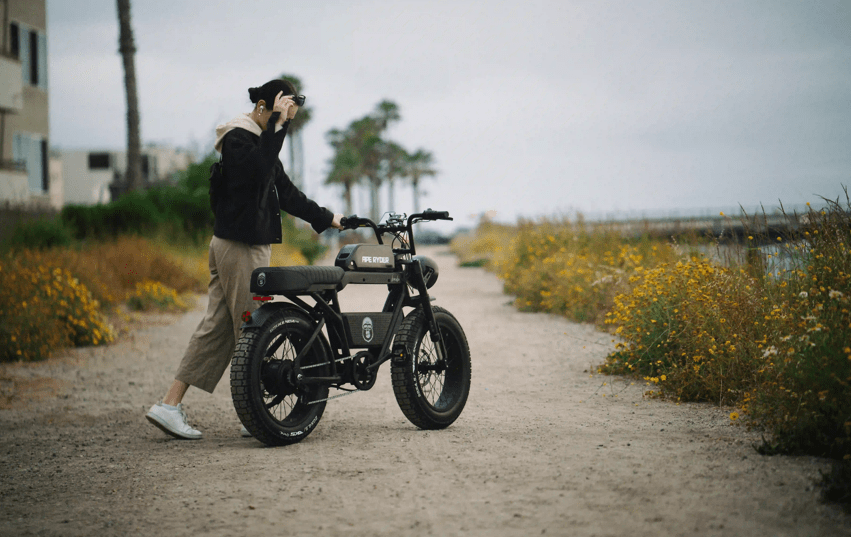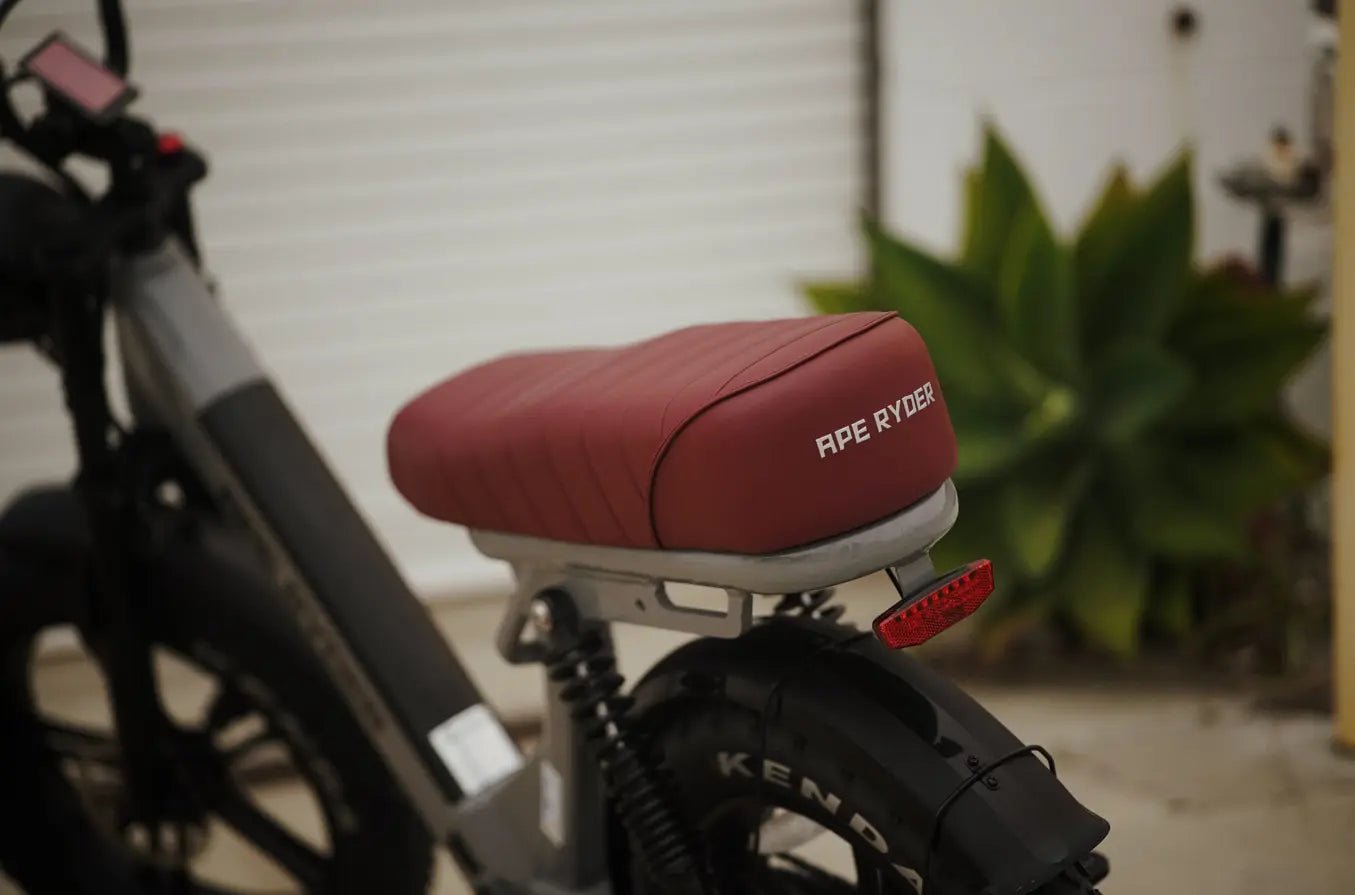Electric Bike Size Charts
Whether you are a veteran cyclist or a newcomer to biking, but are just looking for an environmentally friendly daily commute, proper e-bike size is everything. Proper fitting to an e-bike ensures comfort and vastly affects efficiency and your riding experience in general. This all-in-one guide is going to aid you in learning everything about picking the best e-bike size for your needs—from frame geometry down to your riding style.
Why E-Bike Size Matters?
Correct e-bike size choice should not only be done for comfort purposes; it may well affect your safety and performance. A poorly fitted bike can just ensure that one has discomfort and perhaps even an injury over some time. In contrast, properly fitting e-bikes can enhance your agility, stability, and control to a great degree.
Electric Bike Size Chart for Commuter Women
| Rider Height | Inseam Length | Frame Size (Inches) |
|---|---|---|
| 5'0" - 5'3" (152 - 160 cm) | 27" - 29" (69 - 74 cm) | 15" - 16" |
| 5'3" - 5'7" (160 - 170 cm) | 29" - 31" (74 - 79 cm) | 16" - 17" |
| 5'7" - 5'10" (170 - 178 cm) | 30" - 32" (76 - 81 cm) | 17" - 18" |
| 5'10" - 6'0" (178 - 183 cm) | 32" - 34" (81 - 86 cm) | 18" - 19" |
Electric Bike Size Chart for Commuter Men
| Rider Height | Inseam Length | Frame Size (Inches) |
|---|---|---|
| 5'3" - 5'5" (160 - 165 cm) | 28" - 30" (71 - 76 cm) | 16" - 17" |
| 5'5" - 5'7" (165 - 170 cm) | 29" - 31" (74 - 79 cm) | 17" - 18" |
| 5'7" - 5'10" (170 - 178 cm) | 30" - 32" (76 - 81 cm) | 18" - 19" |
| 5'10" - 6'0" (178 - 183 cm) | 32" - 34" (81 - 86 cm) | 19" - 20" |
| 6'0" - 6'2" (183 - 188 cm) | 33" - 35" (84 - 89 cm) | 20" - 21" |
| 6'2" - 6'4" (188 - 193 cm) | 34" - 36" (86 - 91 cm) | 21" - 22" |
| 6'4" and above (193 cm +) | 35" and above (89 cm +) | 22" and above |
Folding E-Bike Size Chart for Women
| Rider Height | Inseam Length | Frame Size (Inches) |
|---|---|---|
| 5'0" - 5'5" (152 - 165 cm) | 27" - 30" (69 - 76 cm) | One Size (Adjustable) |
| 5'5" - 5'10" (165 - 178 cm) | 30" - 32" (76 - 81 cm) | One Size (Adjustable) |
| 5'10" - 6'0" (178 - 183 cm) | 32" - 34" (81 - 86 cm) | One Size (Adjustable) |
Folding E-Bike Size Chart for Men
| Rider Height | Inseam Length | Frame Size (Inches) |
|---|---|---|
| 5'3" - 5'7" (160 - 170 cm) | 28" - 31" (71 - 79 cm) | One Size (Adjustable) |
| 5'7" - 6'0" (170 - 183 cm) | 30" - 32" (76 - 81 cm) | One Size (Adjustable) |
| 6'0" - 6'4" (183 - 193 cm) | 32" - 36" (81 - 91 cm) | One Size (Adjustable) |
E-Mountain Bike (E-MTB) Size Chart for Women
| Rider Height | Inseam Length | Frame Size (Inches) |
|---|---|---|
| 5'0" - 5'3" (152 - 160 cm) | 27" - 29" (69 - 74 cm) | 15" - 16" |
| 5'3" - 5'7" (160 - 170 cm) | 29" - 31" (74 - 79 cm) | 16" - 17" |
| 5'7" - 5'10" (170 - 178 cm) | 30" - 32" (76 - 81 cm) | 17" - 18" |
| 5'10" - 6'0" (178 - 183 cm) | 32" - 34" (81 - 86 cm) | 18" - 19" |
E-Mountain Bike (E-MTB) Size Chart for Men
| Rider Height | Inseam Length | Frame Size (Inches) |
|---|---|---|
| 5'3" - 5'5" (160 - 165 cm) | 28" - 30" (71 - 76 cm) | 16" - 17" |
| 5'5" - 5'7" (165 - 170 cm) | 29" - 31" (74 - 79 cm) | 17" - 18" |
| 5'7" - 5'10" (170 - 178 cm) | 30" - 32" (76 - 81 cm) | 18" - 19" |
| 5'10" - 6'0" (178 - 183 cm) | 32" - 34" (81 - 86 cm) | 19" - 20" |
| 6'0" - 6'2" (183 - 188 cm) | 33" - 35" (84 - 89 cm) | 20" - 21" |
| 6'2" - 6'4" (188 - 193 cm) | 34" - 36" (86 - 91 cm) | 21" - 22" |
Understanding Frame Geometry
The frame is the backbone of any bike, and the geometry of said frame is critical to achieve the perfect fit. The most prominent factors are the top tube length, seat tube angle, and head tube angle. These create very different ride experiences, so knowing a bit about them can make all the difference in making an informed decision toward what suits your needs best.
Top Tube Length
It's the horizontal distance from the headtube to the seat tube. As discussed above, this is one dimension that dramatically affects your reach and overall comfort when riding. A longer top tube will suit riders who are comfortable being a little more stretched out while a shorter top tube will suit the rider who likes to sit up straight.
Seat Tube Angle
This also alters the way you are positioned on the bike and pedal efficiency. A steeper angle places you further forward on the bike, improving transfer of pedal power, while a more relaxed angle allows one to have better comfort over distance.
Head Tube Angle
The head tube angle has a direct effect on the handling characteristics of the bike. A steeper angle quickens and livens up the steering; a slacker one allows the bike to maintain better stability at greater velocity.
Measuring Your Inseam
One key measure for the proper bike size is your inseam, which helps you estimate the standover height—a key factor in making sure you will have no trouble comfortably straddling your stationary bike. On inseam, stand with your back against a wall and a book between the legs in the manner that it would be if it were a bike seat; measure from the floor to the top of the book. This measurement will help you choose a bike that fits you well.
Determining Your Riding Style
The type of riding you are going to do greatly impacts the right e-bike size. From commuting and mountain biking to riding for leisure, each has special sizing considerations for that particular activity.
That is to say, comfort and easy maneuverability become critical for the urban commuter. Most commuter e-bikes have relaxed frame geometry, with the low riding position putting the rider in an upright posture that is easy on the back and neck—perfect for city streets every day.
Mountain bikers will zero in on a frame that provides better control on rough ground. With slacker head tube angles, there is the possibility of stability in company with a longer wheelbase, but a longer top tube could help you balance during steep descents.
Those who like going out for leisurely rides obviously consider comfort at the forefront. Look out for an e-bike with a padded saddle and relaxed frame design, which has now been offered in a step-through frame to offer better ease of mounting and dismounting.
The Importance of Test Rides
Such a test ride can prove very instrumental in choosing the right size e-bike. Most shops will let you take out a demo to get a feel for how you feel on a bike, in different sizes with varying frame geometries. As you ride, pay attention to how the bike feels and riding posture. If you feel any discomfort, that might not be the right bike.
While testing, ensure you can hold the handlebars comfortably without over-stretching. None of your knees should come close to the handlebars at pedal time, and your feet should be able to touch the ground easily with your seat down.
Even if you get that road bike that seems to fit you well, there could still be those small readjustments that may be needed. Fine-tune the saddle height, change the handlebar position, or replace parts like the stem or seat post, and you will be able to fit in perfectly.
Consulting Size Charts
Most e-bike manufacturers provide charts that will lead one in getting the right frame size by taking the height and inseam length. The following charts are useful for this purpose. However, they still fail to encompass other individual body proportions or specific factors related to riding preferences.
For example probably the most common are those based on height. These give you a reasonable guide to what frame size you require, When these are created, they must encompass as many people as possible.
More accurate are inseam based charts. These ensure that you have enough room to stand over your bike, and can well reach the pedals.
Custom Fitting Services
Custom fitting means that an individual is attended to by experts in a one-on-one custom-fitting session. Professional experts bike fitters use specialized tools and techniques to measure your body dimensions in search of that perfect e-bike fit.
During the fitting session, the fitter will obtain precise measurements of your inseam, arm length, and torso length. They will also take into consideration factors such as your riding style and preferences in providing recommendations to adjust your bike seat for comfort and efficiency.
A custom-tailored fitting maximizes ride comfort and efficiency—an extremely useful tool, especially for serious cyclists or those riders who come in all shapes and sizes.
Common Sizing Mistakes to Avoid
Even with all the information, it's pretty easy to get it wrong while selecting the right size for the e-bike. Here are some common mistakes you should avoid:
• While these measurements are valid, overdependence on them might result in a bad fit, especially if your body proportions are a little different. Consider your overall shape and geometry of the body before choosing the right size.
• This can eventually result in a number of discomforts and below-average performances based on a decision that is only based on size charts. Ensure the frame geometry will suit the way you plan to use the bike for both comfort and efficiency.
• Probably one of the biggest mistakes would be purchasing an e-bike without taking a test ride. One has to make sure it is comfortable and serves all your needs.
Conclusion
Finding the perfect size e-bike means comfort and fun. Knowing frame geometry, measuring your inseam, considering riding style, and taking test rides will put you in a much better position. Utilize size charts for even better fits, or take custom-fit services.









Leave a comment
All comments are moderated before being published.
This site is protected by hCaptcha and the hCaptcha Privacy Policy and Terms of Service apply.